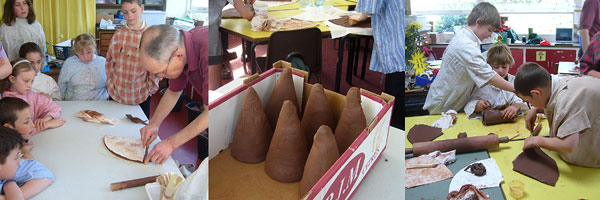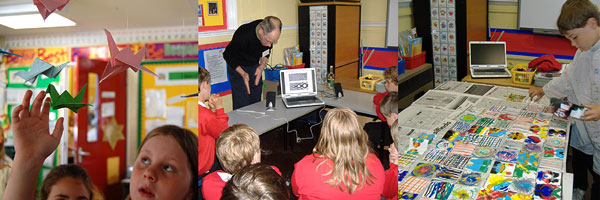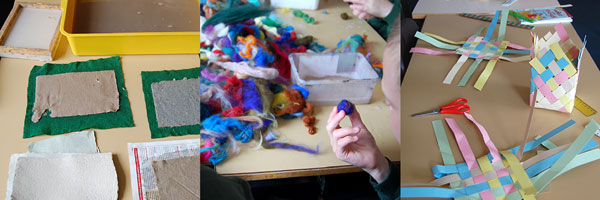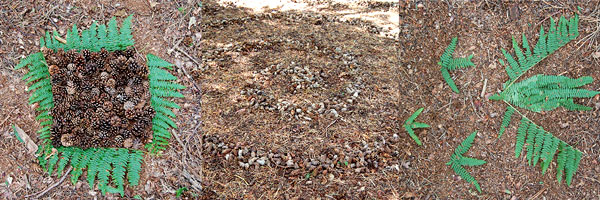Five
half-day workshops were presented individually
for Snape CP School, Benhall St Mary's CEVCP School
and Coldfair Green Primary schools. The workshops
took place spread over the period from March 2008
to the end of the summer term. I point out I am
an artist and not a qualified teacher and I see
my role as to enabling the school and staff to
undertake these art workshops, while wherever
possible offering an open and cross curriculum
learning experience.
Workshop 1: Mapping exercise Based around
drawing this was a way to link the archaeological
workshops with the art workshops and to see what
the children thought about Ebb and Flow. Looking
at aerial photographs and drawn maps of the area
it was an exercise in spatial awareness and interpreting
what they knew on the ground (having visited a
number of archaeological sites) and how to transfer
photographic information into a drawing. Starting
with a small piece of paper the children make
a start on their drawing, I then stick on another
small sheet asking for the drawing to extend onto
that. This continues until each child creates
a large composite map.

Workshop2:
Introduction to working life of an Artist Set
up as a pre-prepared questions and answers illustrated
talk into the life of an artist I spoke about
my own experience. The good and bad points and
the different ways an artist generates an income.
We also spoke of the role the arts play in society,
from popular culture to so called high culture.
I then use the three artworks I had proposed for
the Sailors path as case studies of how an artist
develops ideas and caries through a project. The
children where then incorporated into this process
and helped by each making a couple of the ceramic
cones. Comment was passed that it was unusual
for the children to have the opportunity to work
with such large amounts of clay.

Workshop
3: Patterns From the starting point of Ebb
& Flow in the river this workshop looked at natural
cycles as patterns, developing into patterns in
nature and cultural patterns. This was picked
up in the importance of pattern in thought and
process, with each child folding a sculptural
paper bird, which brought together created a larger
flock of birds to hang in the classroom. Using
computer audio software we also looked at pattern
in sound, overlaying simple clapping patterns
and looked at other computer-generated pattern
animations. The session was finished off considering
pattern in painting, such as Jackson Pollock and
Damien Hirst. The children then did their own
‘spin’ paintings, ‘drip’ paintings and ‘squish’
symmetry paintings.

Workshop
4: Art Nature and Culture This workshop was
based around making, particularly the craft of
working with natural materials. Fist looking at
the sort of things that are made in the natural
word, like weaverbird nests, paper wasp nests,
potter wasp nests, silk worm cocoons. We then
look at man made objects such as baskets, pots,
paper making, felted textiles and woven textiles.
With this information the children undertook three
practical projects. Papermaking, felt bead making
and basket weaving – using card. Simple card looms
where also available to see the similarities between
textile weaving and basket weaving.

Workshop
5: Walking the path The last workshop took
place on the Sailors path. We walked part of the
path seeing two of the three sculptures, especially
‘Crossed Paths’, the artwork the children had
helped with. Along the route we stopped off to
do some environmental art interventions, making
use of the materials around us. In particular
we looked at contrast, thinking about contrast
in our own lives but also how in simple terms
one material, or colour or texture can be contrasted
against another.

Children’s
Feedback
“It has been the best year I have had. It was
fantastic when we had a real artist.”
“I have enjoyed the activities but I think the
origami birds were really challenging.”
“My favourite thing has to be making clay pots
because I love touching clay and I like being
creative and I feel proud that everyone can see
our art work on the field.”
“It was good to see our own pots in the field
and it made me very proud to see all our wonderful
work in there for everyone to see when they walked
past.”
“My favourite activity was the walk on the sailor’s
path and the drawings on the floor.”
“My favourite activity was the spin painting because
you make really strange patterns.”
“Our favourite was making felt balls. I was really
good at making them and afterwards my hands were
as clean as my plates are when they are washed.”
“The hardest activity is the basket weaving because,
we kept getting into a muddle and the pieces of
paper went all over the place! But in the end
it turned out into a tremendous, marvellous and
a fabulous basket! I do wish that we could do
that again with you because it was so much fun!”
“My favourite activities were making clay cones
because it felt like we were real hard working
potters, basket making because it was very fiddly
and finding out about your job and different types
of art.”
“My favourite activities was all of them they
were fantastic.”
“We won’t forget every thing we have done with
you. We will treasure it for the rest of our lives!”
“I wish that there were more ebb + flow to come
so that we can do more artwork.”